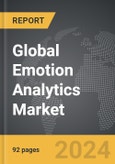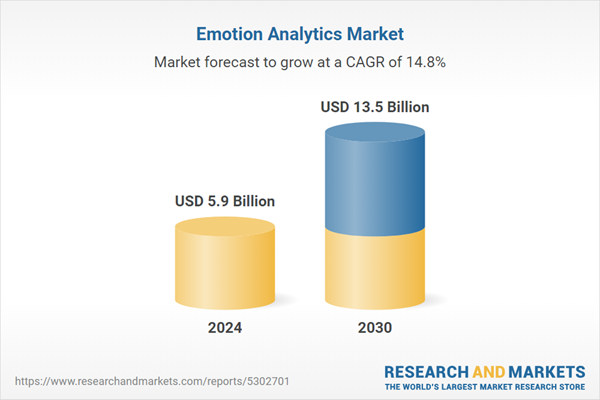Global Emotion Analytics Market - Key Trends & Drivers Summarized
Why Is Emotion Analytics Transforming Customer Insights and Behavioral Analysis?
Emotion analytics is an emerging field that uses artificial intelligence (AI), machine learning, and data analytics to interpret human emotions by analyzing facial expressions, voice tone, text, and physiological signals. By capturing emotional cues, emotion analytics provides deeper insights into consumer behavior, enhancing the ability of businesses to understand customer preferences, improve product offerings, and personalize experiences. Emotion analytics is widely applied in industries such as retail, healthcare, entertainment, and customer service, where understanding human emotions can lead to better engagement, higher satisfaction, and more effective decision-making.In customer service, emotion analytics can help agents assess customer sentiment in real time, enabling timely responses that address the customer's emotional state, leading to improved customer satisfaction and brand loyalty. In retail, emotion analytics is used to evaluate customer reactions to products, advertisements, and shopping experiences, allowing brands to refine their marketing strategies based on real-time emotional data. This technology is revolutionizing how businesses engage with customers, moving beyond traditional metrics to gain a nuanced understanding of what motivates and impacts consumer decisions, ultimately driving more informed and empathetic interactions.
How Are Technological Advancements Shaping the Emotion Analytics Market?
Technological advancements in AI, machine learning, and biometric sensors are significantly enhancing the capabilities and accuracy of emotion analytics, making it more applicable across various industries. One of the most transformative developments is the use of deep learning algorithms that can process vast amounts of data from facial expressions, vocal intonations, text sentiment, and biometric signals, providing a multi-dimensional view of emotions. Facial recognition technology has seen major improvements in speed and accuracy, allowing for real-time emotion detection and analysis even in crowded or complex environments, which is particularly valuable in sectors like retail, healthcare, and education.Voice emotion analysis has also evolved, with natural language processing (NLP) techniques enabling systems to interpret subtle variations in tone, pitch, and cadence, making it possible to detect emotional changes in phone conversations, video chats, and virtual assistants. Wearable devices and biometric sensors, which measure heart rate, skin temperature, and other physiological responses, are contributing to a more precise understanding of emotions in real-world scenarios, supporting applications in healthcare and human resources. These technological advancements are making emotion analytics more robust, accessible, and accurate, enabling it to offer highly personalized insights and create more meaningful interactions between businesses and customers.
What Are the Key Applications of Emotion Analytics Across Industries?
Emotion analytics is applied in numerous industries to enhance customer experience, improve decision-making, and support mental health and well-being. In the retail industry, emotion analytics is used to track customers' emotional responses to advertisements, store layouts, and product displays, enabling brands to refine marketing strategies and store designs based on real-time feedback. By analyzing facial expressions and sentiment, retailers can assess how customers feel about a product or experience, driving adjustments to inventory, pricing, or promotions based on consumer emotion trends.In healthcare, emotion analytics plays a valuable role in mental health assessments, tracking patients' emotional responses over time to detect signs of anxiety, depression, or other emotional shifts. Wearable devices integrated with emotion analytics can help mental health professionals monitor patients remotely, allowing for timely interventions when emotional distress is detected. In customer service, emotion analytics enables companies to gauge customer satisfaction in real time, providing insights into customer sentiment during interactions that can guide agents in adjusting their responses accordingly. Additionally, emotion analytics is becoming prevalent in media and entertainment, where it helps creators understand audience reactions to content, optimizing viewer engagement and personalizing media recommendations. These applications demonstrate the versatility of emotion analytics in supporting data-driven, empathetic strategies across industries.
What Is Driving Growth in the Emotion Analytics Market?
The growth in the emotion analytics market is driven by increasing demand for personalized customer experiences, technological advancements, and the need for improved mental health monitoring. As businesses across industries aim to understand consumer behavior more deeply, emotion analytics offers a competitive edge by providing insights into customer emotions that go beyond traditional metrics. The rise of digital and remote customer interactions has further heightened the demand for emotion analytics, as companies seek to replicate the nuances of in-person engagement in virtual environments. Personalized interactions enabled by emotion analytics help build stronger customer relationships, supporting brand loyalty and long-term engagement.Technological advancements in AI, machine learning, and biometric sensing are making emotion analytics more accurate and scalable, supporting its adoption across diverse sectors. The healthcare sector, in particular, is seeing increased adoption of emotion analytics as mental health and well-being gain attention, especially in remote care and telehealth contexts. Emotion analytics provides mental health professionals with valuable, real-time insights into patient states, supporting preventive care and timely intervention.
Additionally, regulatory and ethical considerations around data privacy and emotional intelligence are shaping the market, with governments encouraging responsible data collection practices to protect user privacy. Together, these factors - demand for personalized experiences, advancements in technology, increased focus on mental health, and regulatory support - are driving robust growth in the emotion analytics market, positioning it as a transformative tool in customer experience management and behavioral analysis across industries.
Report Scope
The report analyzes the Emotion Analytics market, presented in terms of market value (US$ Thousand). The analysis covers the key segments and geographic regions outlined below.- Segments: Application (Customer Experience Management, Sales & Marketing Management, Competitive Intelligence, Public Safety & Law Enforcement, Workforce Management); Vertical (Retail, BFSI, IT & Telecom, Healthcare, Media & Entertainment, Other Verticals).
- Geographic Regions/Countries:World; United States; Canada; Japan; China; Europe (France; Germany; Italy; United Kingdom; Spain; Russia; and Rest of Europe); Asia-Pacific (Australia; India; South Korea; and Rest of Asia-Pacific); Latin America (Argentina; Brazil; Mexico; and Rest of Latin America); Middle East (Iran; Israel; Saudi Arabia; United Arab Emirates; and Rest of Middle East); and Africa.
Key Insights:
- Market Growth: Understand the significant growth trajectory of the Customer Experience Management Application segment, which is expected to reach US$4.6 Billion by 2030 with a CAGR of a 16.7%. The Sales & Marketing Management Application segment is also set to grow at 14.8% CAGR over the analysis period.
- Regional Analysis: Gain insights into the U.S. market, valued at $1.5 Billion in 2024, and China, forecasted to grow at an impressive 19.2% CAGR to reach $3.5 Billion by 2030. Discover growth trends in other key regions, including Japan, Canada, Germany, and the Asia-Pacific.
Why You Should Buy This Report:
- Detailed Market Analysis: Access a thorough analysis of the Global Emotion Analytics Market, covering all major geographic regions and market segments.
- Competitive Insights: Get an overview of the competitive landscape, including the market presence of major players across different geographies.
- Future Trends and Drivers: Understand the key trends and drivers shaping the future of the Global Emotion Analytics Market.
- Actionable Insights: Benefit from actionable insights that can help you identify new revenue opportunities and make strategic business decisions.
Key Questions Answered:
- How is the Global Emotion Analytics Market expected to evolve by 2030?
- What are the main drivers and restraints affecting the market?
- Which market segments will grow the most over the forecast period?
- How will market shares for different regions and segments change by 2030?
- Who are the leading players in the market, and what are their prospects?
Report Features:
- Comprehensive Market Data: Independent analysis of annual sales and market forecasts in US$ Million from 2024 to 2030.
- In-Depth Regional Analysis: Detailed insights into key markets, including the U.S., China, Japan, Canada, Europe, Asia-Pacific, Latin America, Middle East, and Africa.
- Company Profiles: Coverage of players such as Adoreboard, Affectiva, Beyond Verbal, Cogito, Google and more.
- Complimentary Updates: Receive free report updates for one year to keep you informed of the latest market developments.
Some of the 36 companies featured in this Emotion Analytics market report include:
- Adoreboard
- Affectiva
- Beyond Verbal
- Cogito
- Gorilla Technology
- IBM
- iMotions
- Kairos
- Lexalytics
- Microsoft
- Noldus Information Technology
- NVISO
- Sensum
- Sentiance
- Tobii
This edition integrates the latest global trade and economic shifts into comprehensive market analysis. Key updates include:
- Tariff and Trade Impact: Insights into global tariff negotiations across 180+ countries, with analysis of supply chain turbulence, sourcing disruptions, and geographic realignment. Special focus on 2025 as a pivotal year for trade tensions, including updated perspectives on the Trump-era tariffs.
- Adjusted Forecasts and Analytics: Revised global and regional market forecasts through 2030, incorporating tariff effects, economic uncertainty, and structural changes in globalization. Includes historical analysis from 2015 to 2023.
- Strategic Market Dynamics: Evaluation of revised market prospects, regional outlooks, and key economic indicators such as population and urbanization trends.
- Innovation & Technology Trends: Latest developments in product and process innovation, emerging technologies, and key industry drivers shaping the competitive landscape.
- Competitive Intelligence: Updated global market share estimates for 2025, competitive positioning of major players (Strong/Active/Niche/Trivial), and refined focus on leading global brands and core players.
- Expert Insight & Commentary: Strategic analysis from economists, trade experts, and domain specialists to contextualize market shifts and identify emerging opportunities.
Table of Contents
Companies Mentioned (Partial List)
A selection of companies mentioned in this report includes, but is not limited to:
- Adoreboard
- Affectiva
- Beyond Verbal
- Cogito
- Gorilla Technology
- IBM
- iMotions
- Kairos
- Lexalytics
- Microsoft
- Noldus Information Technology
- NVISO
- Sensum
- Sentiance
- Tobii
Table Information
| Report Attribute | Details |
|---|---|
| No. of Pages | 214 |
| Published | December 2025 |
| Forecast Period | 2024 - 2030 |
| Estimated Market Value ( USD | $ 5.9 Billion |
| Forecasted Market Value ( USD | $ 13.5 Billion |
| Compound Annual Growth Rate | 14.8% |
| Regions Covered | Global |









